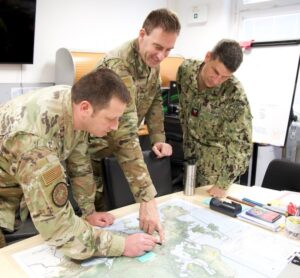
Story by Janet A. Aker
Defense Health Agency
The Defense Health Agency tracked more than 500 transports from the front lines to hospitals of simulated casualties during the computer exercise Operation Austere Challenge 2024, March 4–14. Austere Challenge is an annual classified exercise in response to a fictional military crisis.
It is run by the U.S. European Command, responsible for U.S. military operations across Europe, parts of Asia and the Middle East, the Arctic, and the Atlantic Ocean. It is designed to increase interoperability between U.S. armed forces and North American Treaty Organization members.
As part of the exercise planning phase, USEUCOM tested the Joint Patient Evacuation Coordination Center, or JPECC, under development by the Joint Patient Movement Work Group, led by the Department of Defense’s Joint Trauma System, also known as the DOD Center of Excellence for Trauma, said Teresa Duquette-Frame, JTS deputy chief for clinical operations. JPECC is a solution for planning, coordinating, and synchronizing intratheater patient movement requirements.
During its second consecutive year of participation in Austere Challenge, DHA tracked casualties from Role 1 to Role 4 medical care, the most definitive medical care available within the medical health care system.
Role 1 care provides specialized first aid, triage, resuscitation, and stabilization. Role 2 care provides more advanced medical support in the field and can be augmented by surgical teams to provide damage control surgical procedures. A Role 3 field hospital is equivalent to a multidisciplinary general hospital. Role 4 care provides the full range of preventive, acute, restorative, curative, rehabilitative, and convalescent care found in United States base hospitals and robust overseas facilities. The usual highest level of medical care for forward casualties is Role 2/3 facilities or host nation medical facilities.
By having a large volume of casualties, DOD was able to stress test JPECC and “its ability to maintain situational awareness of forward casualty evacuation to the rear of the forward operating area and jointly plan, coordinate, and synchronize further evacuation to DHA Role 4 facilities,” Duquette-Frame said. The simulated casualties came from the U.S Army V Corps based in Poland.
Landstuhl Regional Medical Center, Germany, the largest U.S. hospital overseas, provided Role 4 support. Landstuhl has the Theater Patient Movement Requirement Center-East, and Aeromedical Evacuation, said Edward King, the DHA liaison officer to EUCOM. He observed AC24 on the ground from Germany.
DHA monitored the exercise using these information technology systems: the U.S. Transportation Command Patient Movement Requirements Center-East, with its computer-based TRANSCOM Regulating and Command & Control Evacuation System for casualty tracking, Ramstein Air Base, Germany; USTRANSCOM Regulating and Command & Control Evacuation, which coordinates missions worldwide using both military and commercial transportation resources; and the Joint Medical Information System and its secure Medical Common Operating Picture training server, King said.
JOMIS provides interoperable medical IT capabilities across the full spectrum of military operations. MedCOP is an interactive decision-support platform arming command surgeons and medical commanders with near real-time health surveillance and medical operations visibility to enable well-informed decisions.
Additionally, the Joint Chiefs of Staff exercise dubbed Global Information Dominance Experiment 9 monitored patient movement IT systems and usage. The GIDE 9 experiment is aimed at applying AI decision-making tools to realistic scenarios.
Austere Challenge Background
AC24 is part of an exercise series ongoing since the 1990s that focuses on training combatant command coordination, command and control, and the integration of capabilities and functions across USEUCOM’s headquarters, its component commands, other combatant commands, and U.S. government agencies.
“Exercises such as Austere Challenge are designed to test responsiveness and decision-making, and to improve military capabilities and readiness across all domains in times of crisis. Exercises are meant to enhance U.S. readiness and support to NATO to accomplish any mission. Every opportunity to train is an opportunity to improve our combined military capabilities,” USEUCOM said.
AC24 took place throughout Germany, ranging from USEUCOM’s headquarters at Patch Barracks, Stuttgart, and the various components’ locations, as well as other participating combatant command locations. Partnering nations’ militaries included Canada, Denmark, Estonia, Finland, France, Germany, Lithuania, Norway, Poland, Romania, Sweden, and the United Kingdom.
This year, Austere Challenge was linked to three other U.S. joint force exercises: U.S. Cyber Command’s Cyber Guardian; the North American Aerospace Defense Command and U.S. Northern Command’s Vigilant Shield; and the U.S. Strategic Command’s Global Lightning.